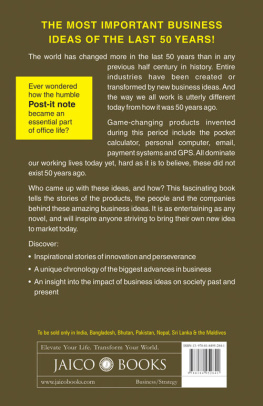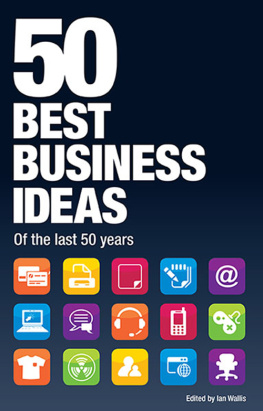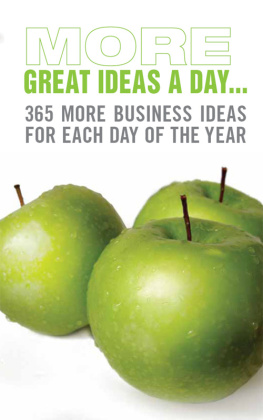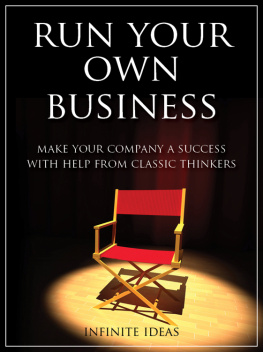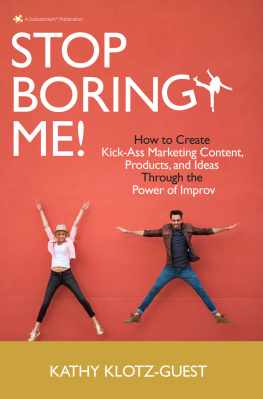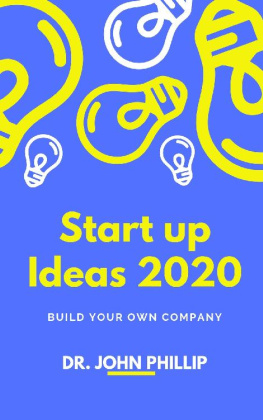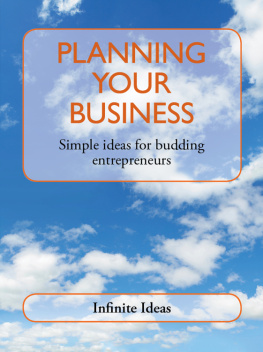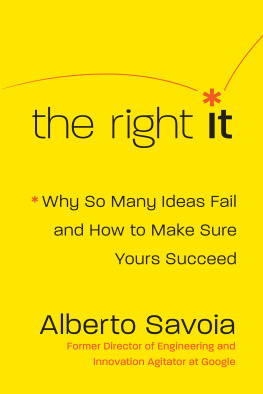Published by Jaico Publishing House
A-2 Jash Chambers, 7-A Sir Phirozshah Mehta Road
Fort, Mumbai - 400 001
www.jaicobooks.com
Crimson Publishing
Original English language edition published by
Crimson Publishing
Westminster House, Kew Road
Richmond, Surrey, TW9 2ND, UK
All Rights Reserved.
To be sold only in India, Bangladesh, Bhutan,
Pakistan, Nepal, Sri Lanka and the Maldives.
50 BEST BUSINESS IDEAS THAT CHANGED THE WORLD
ISBN 978-81-8495-284-1
First Jaico Impression: 2012
No part of this book may be reproduced or utilized in
any form or by any means, electronic or
mechanical including photocopying, recording or by any
information storage and retrieval system,
without permission in writing from the publishers.
Acknowledgements
50 Best Business Ideas is certainly a collaborative effort. Conceived in 2010 by David Lester, the book has only made it through to publication because of the significant input of many people.
At the outset, David's initial brainstorm provided a skeleton list of ideas. This was embellished by business school professors, investors and successful entrepreneurs, as well as members of Crimson's business editorial team. I would also like to extend particular gratitude to Kamal Ahmed, business editor at the Sunday Telegraph for his valuable input.
Sara Rizk followed the initial brief to perfection to create a template chapter on the modest Post-it note and, alongside me, commissioned some of the early chapters. Others at Crimson, namely Stephanie Welstead, Gareth Platt and Georgina-Kate Adams, worked tirelessly in the latter stages to elevate the stories from a potted history to something of meaning and usefulness for lovers of business and great ideas.
Many journalists contributed chapters, namely Gareth Platt (8), John O'Hanlon (8), Ryan Platt (8), Jon Card (6), Emma Haslett (3), Georgina-Kate Adams (2), Henrietta Walsh (2), Hannah Prevett (2), Nicole Farrell (2), Hugh Jordan (2), Sara Rizk, Peter Crush, Carys Matthews, Trevor Clawson, Mark Shaw and Martin James.
Picture research for 50 Best Business Ideas was co-ordinated by Beth Bishop and Lucy Elizabeth Smith, with much of the time-consuming and determined research carried out by Lucy, Abigail Van-West and Francesca Jaconelli. Between them, they unearthed a treasure trove of incredible images dating back to the very first products that made it to market, and their enthusiasm and effort is worthy of thanks. Equally, Samantha Harper painstakingly fact-checked each and every chapter.
I would also like to thank a number of others at Crimson who have helped to ensure this book made it through the final stages, namely Lucy Smith, Gemma Garner, Clare Blanchfield and especially Jonathan Young in marketing, and Jo Jacomb and Dawn Wilkinson in production. Dawn's patience, in particular, is worthy of extra appreciation here. Knowledgeable colleagues such as Hugh Brune, Trudi Knight and Kevin Paul carried out some crucial sense-checking of initial chapter drafts. And finally, I would like to thank my wife and three sons, who were incredibly supportive throughout.
Introduction
For thousands of years, ingenious minds have grappled with the world's conundrums, desperate for the solutions capable of making a tangible difference to the way we live and work.
50 Best Business Ideas celebrates the greatest business ideas of the past 50 years. In the past half-century alone, some highly influential ideas and innovations have emerged that have had a profound impact on business and society. Why the last 50 years? As a period, it rivals the industrial revolution for economic advancement. The 'computer age' has enabled instant access to information and knowledge. The processes of miniaturisation and digitisation have made advanced technology more portable. And globalisation and commoditisation have dramatically enhanced the commercial potential of any market innovation.
Each of the ideas has been undeniably transformative. Many remain core to our daily existence: the PC, the internet, satellite TV and barcodes, to name a few. Some are controversial: the disposable nappy, the contraceptive pill, aerosol deodorant and plastic bags have had an enormous impact, irrespective of the negative press they have received. And there are ideas that have declined in influence already: such as the fax machine, the Post-it note, the Walkman and the pocket calculator, which were outmoded by digitised versions, but nevertheless critical as evolutionary landmarks.
In identifying and acclaiming the individuals and companies that changed the world, we offer a nod to the incredible foresight of the people who had the germ of an idea and set the ball rolling.
Great stories
There are some fantastic stories contained within this book, some of which you may have heard of, but also many that will surprise and enthral, if only for the way such major contributions to the world came about through happenstance. For example, the inventions of Kevlar, smoke alarms, microwave ovens and the Post-it note, as we know them now, had an element of serendipity about them, only happening because scientific experiments went wrong. Kevlar, the polymer used in body armour and innumerable other applications for its impervious qualities, was stumbled upon when scientist Stephanie Kwolek of DuPont decided not to throw away the cloudy, runny substance and instead spun it into a fibre to see what happened. It turned out this fibre was stronger than any other previously created and one now responsible for a multi-billion dollar income for licensor DuPont each year.
Likewise, the smoke alarm was created when a detector for poisonous gases failed to produce the desired response. When Swiss physicist Walter Jaeger decided to take a cigarette break from his toils, he noticed the smoke had triggered the sensors. While it wasn't he who went on to create the domestic smoke alarm we know today, the timeframe for a commercially viable version would surely have been more prolonged without his discovery. And the Post-it note was ultimately arrived at after Dr Spencer Silver's adhesive failed to bond fully with other surfaces. When colleague Art Fry used the weak glue to stick small pieces of paper as temporary bookmarks in his hymn book, the Post-it note was effectively born.
The idea for a ring pull on food and drink cans emerged from the mind of Ermal Fraze when he forgot his beer can opener while having a picnic in 1959. It took him a few years and some effort, but when the 'pull-tab' launched (or 'snap top' as it was known then) it was an instant success, and has had a fundamental impact on the consumption of food and drink the world over. Another food-related invention, the microwave oven, only transpired because of a partially melted chocolate and peanut bar. Dr Percy Spencer of defence contractor Raytheon stood next to a magnetron system during testing in 1944 and found that his snack bar had inadvertently been heated by the experiment. The company patented the idea for the use of microwaves in the cooking process in 1945 and invented an unwieldy oven some years later. It wasn't until 1965 that a worthy product was created for domestic use, however.
Regarding the invention of fibre optics, it's telling that the first presentation suggesting light could be used as a transmission medium was laughed at by professional engineers. It didn't stop (now Sir) Charles Kao from pursuing such an unlikely dream. Showing similar perseverance, VHS only came to market when it did because two employees at JVC carried on working on a de-prioritised project. And most of us have heard about (now Sir) James Dyson's 5,000+ prototypes prior to the launch of his Dual Cyclone vacuum cleaner.
For those who enjoy tales of conflict, there's the story of the three scientific teams who went to war over who had the right to proclaim themselves the inventor of Magnetic Resonance Imaging (MRI), and there's the German-Brazilian Andreas Pavel who fought Sony for 20 years for the right to be known as the inventor of a Walkman-like device, a battle the Japanese conglomerate settled out of court. Pavel ran up a $3.6m legal bill and came close to bankruptcy for the recognition he felt he deserved. You'll undoubtedly find intrigue, inspiration and considerable amounts of information in each of the stories.
Next page
